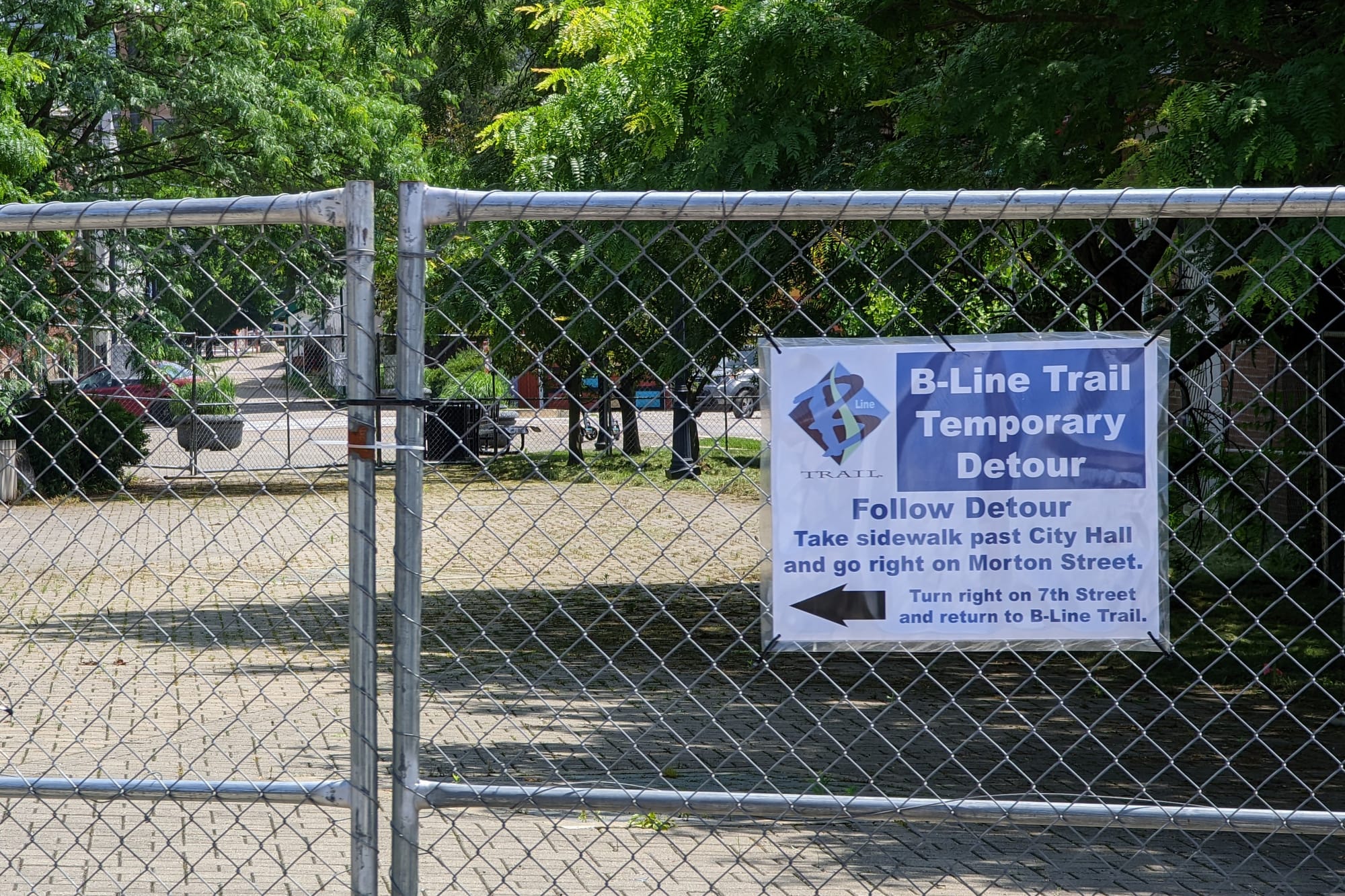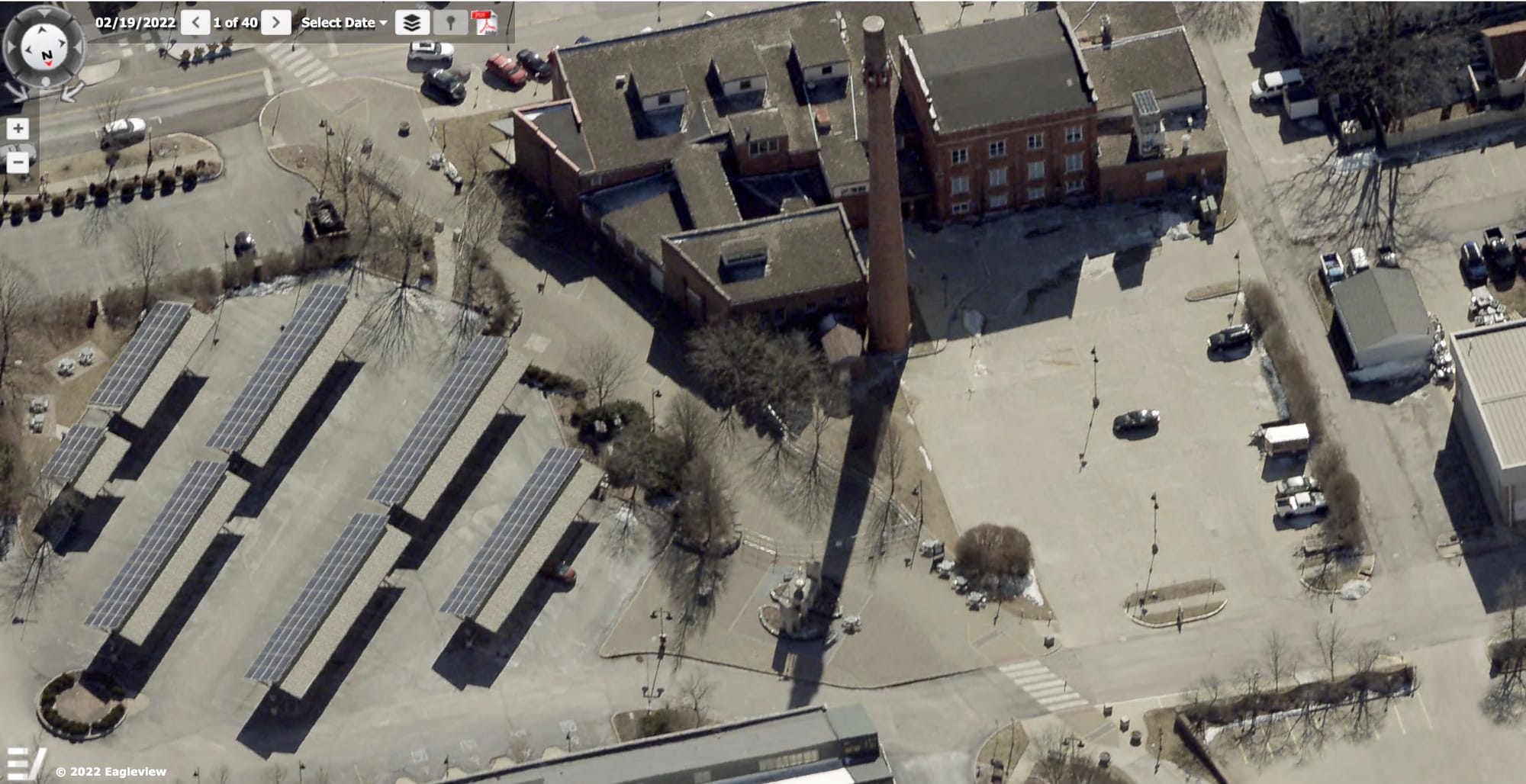“Piss-poor” B-Line detour design prompts scrutiny of right-of-way definition by city traffic commission





On Wednesday, at Bloomington’s traffic commission meeting, a question from commissioner Greg Alexander left city attorney Mike Rouker stumped:
“If I was to ask the question, ‘What is the B-Line right-of-way within the terms of Chapter 12.08?’ where would I look, if not the transportation plan?”
Rouker’s answer: “I don’t know the answer to that question off the top of my head.”
The question came after a sharp back-and-forth between Rouker and Alexander about whether the B-Line is right-of-way, according to the city’s adopted transportation plan.
The backdrop of the discussion was the January closure of the B-Line in connection with the hazard posed by the Johnson’s Creamery smokestack. The smokestack has now been partially demolished down to 60 feet, and the trail has re-opened.
Alexander’s point: If the B-Line had been treated as the right-of-way that he believes it to be, and a traffic engineer, instead of the parks department, had needed to sign off on the design of the detour, the users of the trail would have been given a safer and better designed detour from the very start of the closure.
Earlier in the meeting, Rouker had rejected the idea that the transportation plan was the right place to look, to determine if the B-Line is right-of-way. That’s why Alexander wanted to know where else to look, if not the transportation plan.
The exchange between Alexander and Rouker came in the context of commission deliberations about a resolution that Alexander had proposed, which would recommend an ordinance change to the city council. The ordinance change would make explicit in city code that The B-Line is right-of-way.
Based on the content of Bloomington’s transportation plan, the logical inference that can be drawn is that the B-Line already qualifies as right-of-way, as defined under the terms of the plan.
That’s why at Wednesday’s meeting, Alexander was looking for an acknowledgment from Rouker that the city’s transportation plan points to the B-Line Trail as right-of-way. Rouker rejected the idea that the transportation plan was the right place to look for the answer to the question: Is the B-Line right-of-way?
Rouker put it like this: “I’m rejecting maybe the premise a little bit here, which is that the transportation plan disposes of the question, whether or not the B-Line is right-of-way, and that all of the legal consequences of something being right-of-way, therefore apply to the B-Line.”
Rouker said the wording in the transportation plan about the B-Line would not be analyzed in the same way as “a direct statement in an ordinance that we’re declaring it right-of-way”
The impact of adopting an ordinance explicitly to recognize the B-Line Trail as right-of-way would be that under city code, the city’s traffic engineer would have to approve an application for any closure of the trail.
Under the ordinance change advocated by Alexander, the city engineer—not the director of parks or the board of park commissioners—would have to sign off on closures and detours for the B-Line.
The B-Line is part of the city’s parks system, so the city treats the B-Line as a park amenity. The current approach is for parks staff to “consult” with the city engineer, but to let the authority for closures and detours for the trail to rest with the parks director or the board of park commissioners.
Alexander’s basic idea is that if a traffic engineer has to sign off on trail closures and detours, people who use the trail for basic transportation will be better served than if the B-Line is treated as an optional, recreational amenity.
What led Alexander to propose a recommendation for an ordinance change?
In mid-January the B-Line was closed in connection with the hazard posed by the Johnson’s Creamery smokestack. The initial detour directed trail users across the city hall parking lot, with a sign printed on a laminated sheet. At Wednesday’s traffic commission meeting, parks operations director Tim Street conceded the first effort at a detour “wasn’t sufficient.”
After a push from Alexander, the parks department revised the detour route in June, so that it no longer directed trail users from the north to turn left, navigate across a parking lot, seek out a sidewalk next to city hall, follow the sidewalk to Morton Street, then turn right.
The new detour led trail users along the western edge of the parking lot, offering protection from parking lot traffic with orange water-filled barricades.
On Wednesday, traffic commissioner Sarah Ryterband said about the revised detour, “It was kind of a piss-poor attempt, if you’ll forgive the expression.”
She continued, “It didn’t really take into account those of us who utilize the B-Line for transportation.”
A specific weakness of the revised detour pointed out by Alexander was the narrow width of one portion, which measured just 5 feet 4 inches. And on at least one Saturday, the parks department allowed a farmers market stall to block the detour route.
Alexander’s proposal that the traffic commission recommend an ordinance change to the city council did not get a vote on Wednesday.
Having previously discussed Alexander’s proposal at their July 27, August 24, September 28 meetings, the consensus on the commission seemed to be that an ordinance was not the right solution. But they agreed that the term “right-of-way” was not well defined generally, and that the specific way the B-Line detour had been handled was not adequate.
At Wednesday’s traffic commission meeting, parks operations director Tim Street showed the commissioners a draft policy that is meant to address what role the engineer plays in closures of trails.
About the B-Line detour, and the collaboration with parks staff, city engineer Andrew Cibor said, “We truly did work together on the enhanced detour with the barricades.”
Street said, “The goal of the policy…for the parks department—I think I can speak for the engineering department, too—is to come to a solution that we all agree on. And in a sense, that is status quo, because we already do work together and come up with some things.”
In response to Street’s description of the draft policy as “status quo,” Ryterband pointed to the inadequacy of the B-Line detour, then wondered: “If this proposal is indeed the status quo and how things already exist between engineering and parks department, then what the hell is going on?”
Alexander was skeptical of the draft policy, because the engineer would play the role of just a consultant. He described his skepticism like this: “Honestly, I don’t have much faith in the parks department’s proposal, mostly because the final approval rests with the parks department. And the engineers are just consultants.”
Alexander added, “Now as an activist, my job is to make the parks department understand that pedestrians matter?? I’m incredulous. That’s not my job!” Alexander continued, “Transportation is not parks’ job. If I’m lobbying transportation people, I should be lobbying engineers, I should be lobbying planners and I should be lobbying public works.”
Alexander concluded, “Parks shouldn’t have anything to do with it.”
The draft policy on trail closures could appear on the next meeting agenda for the board of park commissioners. That meeting falls on Nov. 15.
Audio of the Oct. 26, 2022 Bloomington traffic commission meeting




Comments ()